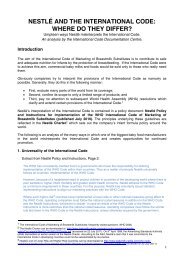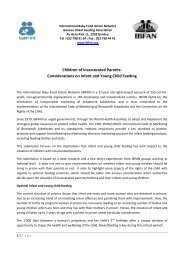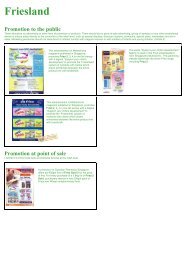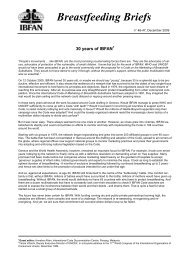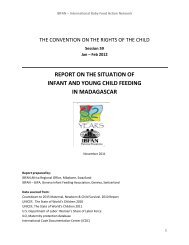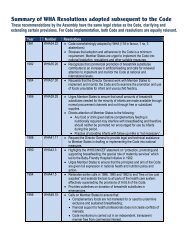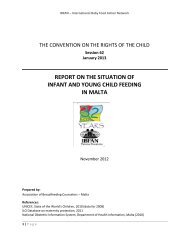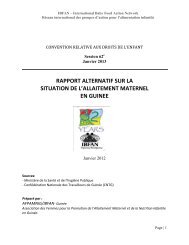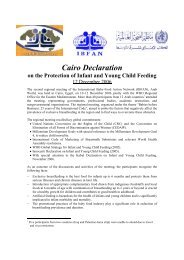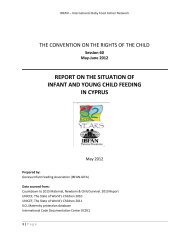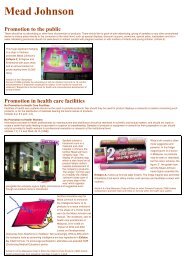AsiA-PAcific - IBFAN
AsiA-PAcific - IBFAN
AsiA-PAcific - IBFAN
You also want an ePaper? Increase the reach of your titles
YUMPU automatically turns print PDFs into web optimized ePapers that Google loves.
labelling<br />
• Article 9 of the Code requires labels to NOT discourage breastfeeding and inform about the<br />
correct use of the product, the risk of misuse and abide by a number of other points.<br />
• WHA resolution 54.2 (2001) advises exclusive breastfeeding for six months which means that<br />
the recommended age for use of complementary foods cannot be under six months.<br />
• WHA resolution 58.32 (2005) prohibits nutrition and health claims, except where specifically<br />
provided for in national legislation.<br />
The Code forbids the use of pictures of infants or other pictures or text idealising<br />
the use of infant formula. Baby faces have disappeared from most labels across the<br />
region but cuddly stuffed animals, toys, cartoon characters and stylised drawings<br />
which create warm and fuzzy feelings are firmly in place. These images are cleverly<br />
turned into promotional icons which are instantly recognisable by the public as<br />
products of specific companies even where product names are not mentioned.<br />
Although health and nutrition claims on labels are no longer allowed except where<br />
specifically provided for in national legislation, such claims are unabashed being<br />
used on labels to promote products in countries where they can get away with it.<br />
Apart from being largely unproven by independent scientific research, such claims<br />
idealise products and should be prohibited.<br />
Although many countries in this region have adopted the global recommendation<br />
Indonesia:<br />
The label of Sari<br />
Husada’s SGM 1<br />
has been revamped<br />
from its orginal<br />
plain pink label to<br />
one displaying a<br />
drawing of a baby<br />
pram in the sun. A<br />
statement advises<br />
that the product<br />
should be used<br />
when breastmilk<br />
is not sufficient to<br />
satisfy baby’s needs.<br />
The claims on the<br />
label include “DHA<br />
to assist in baby’s<br />
brain development”;<br />
“LA (linoleic acid)<br />
as the precursor<br />
for AA, which is<br />
important for brain<br />
development” and<br />
“Prebiotic FOS to<br />
assist digestion and<br />
reduce the risk of<br />
constipation.”<br />
Similar claims are<br />
also made on the<br />
label of Vitalac BL.<br />
In Cambodia, the<br />
label of Dulac<br />
shows a toy dolphin<br />
as a graduate,<br />
implying higher<br />
intelligence as<br />
a result of fatty<br />
acids added to the<br />
formula.<br />
The back of the label<br />
claims “new innovative<br />
formula supporting<br />
brain development.”<br />
The Dupro label<br />
promotes ‘DHA–maxi-<br />
Q’ which also shows a<br />
mortar board pointing<br />
to greater academic<br />
achievements by<br />
babies fed on this<br />
product.<br />
regarding exclusive breastfeeding for six months, complementary foods are still<br />
being labelled as suitable from four months. Cute baby images are frequently<br />
seen on the packing and labelling of these products.<br />
In Malaysia and Thailand, wise and cute ‘humanised’<br />
owls sell milk for babies. Large cutouts of the owls<br />
decorate the walls of private hospitals.<br />
...while in China, the fat mother and baby bird logo<br />
found on NAN and Lactogen appears on breastfeeding<br />
posters in hospitals.<br />
In the Philippines, the labels of Bonna infant formula and<br />
Bonamil Milk Supplement (follow-on formula) claim to have<br />
five nucleotides which “help promote physical growth, increase<br />
resistance to infection and enhance brain development”.<br />
Also in the Philippines, the label of<br />
Nestlé’s Nestogen 1 infant formula claims<br />
that it has DHA and more calcium which<br />
function as “brain building blocks” and<br />
“bone builders”. The pack also advertises<br />
Nestlé cereal and encourages early<br />
weaning with the statement “You may start<br />
giving your baby new improved Nestlé<br />
Baby Cereal, the complete first solid<br />
food” without mention of a specific age<br />
recommendation.<br />
In June 2006, the Dept. of Health issued<br />
a new set of implementing rules and<br />
regulations which ban health and nutrition<br />
claims. This provision has since been upheld as valid by the<br />
Supreme Court in Oct. 2007 and claims should no longer<br />
appear on labels and other company materials.<br />
In Australia, cute baby images on some products. Perhaps most disturbing of all is the label for Heinz Organic<br />
which recommends the product “for all ages” written brightly on its side, followed by smaller letters, the vague<br />
recommendation: “six months and above”.



